ASUS N10JC: the Netbook Goes Corporate
by Jarred Walton on December 24, 2008 4:00 AM EST- Posted in
- Laptops
Performance Evaluation
We're not going to run through an extensive suite of software testing on the N10JC, as you should already know that it aims to be fast enough to be useful rather than to set any performance records. Any CPU intensive tasks are going to struggle, but normal office work and internet surfing posed no serious problem. As this is a Windows XP laptop, we do have to omit testing with PCMark Vantage and 3DMark Vantage, but we did run the older versions along with a couple other tests. Here are the results, with comparisons to other recently tested notebooks. (Sorry -- other than battery life testing on the original ASUS Eee PC, we don't have any comparison points with other networks.)
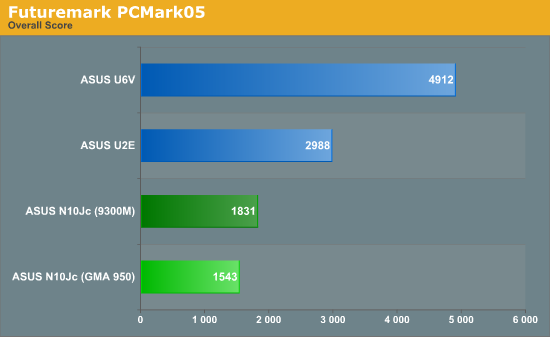
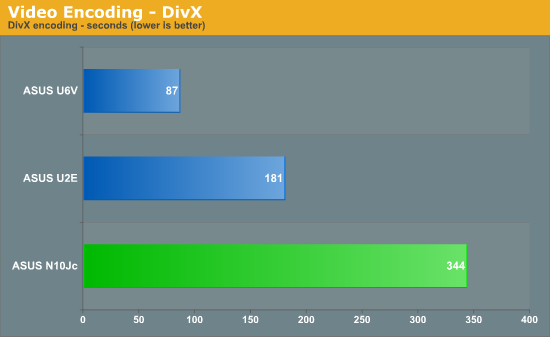
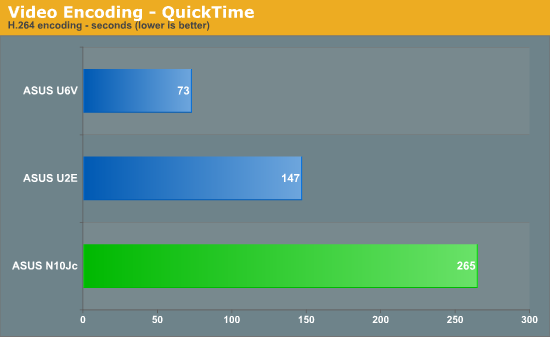
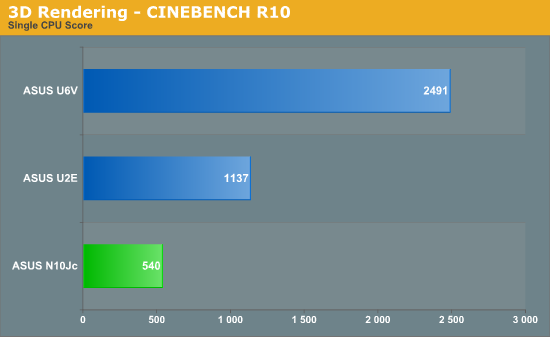
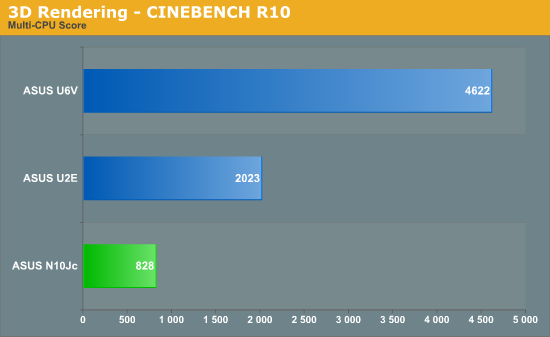
Starting with PCMark, we immediately see that overall performance is going to be quite a bit lower than modern laptops. That's the case with pretty much all of the current netbooks, but you should know going in that you are looking at performance roughly equal to a decent laptop from three years ago.
One interesting point is that the Hyper-Threading present in the Intel Atom chip appears to help a lot more than in other implementations, increasing overall performance by 53% over single threaded rendering. That still can't compete with the 80%+ improvements seen on Core 2 Duo systems, but the in-order Adam core definitely benefits more from SMT than traditional out-of-order architectures.
Overall, performance in CPU intensive tasks is very poor compared to any modern system; obviously, you shouldn't plan to run these tasks on a netbook unless you are very patient. In less strenuous applications, the CPU may not be as much of a bottleneck -- for example, office applications and web surfing were fast enough that we didn't have any serious complaints. Still, it's important to have appropriate expectations.
So if raw performance isn't one of the critical factors, what is? We would certainly rate battery life near the top of the list, so let's look at that next.










45 Comments
View All Comments
DILLIGAFF - Wednesday, December 24, 2008 - link
Thanks for listening :)i checked the download page and the utility is called power4gears hybrid under utilities for n10jc. in the utility you go to performance and in lower left there is a turbo dropdown. change it and save. i used cpuz to verify clocks
supposedly there is a way to wire it to the power profile button but i gave the laptop to my girl before i could get it all done
DILLIGAFF - Wednesday, December 24, 2008 - link
looks like vista only...my bad...ouchpattycake0147 - Wednesday, December 24, 2008 - link
The text of the article on page makes mention of a Western Digital drive while the specs and picture show a Seagate drive. You might want to change the WD to Seagate.Khato - Wednesday, December 24, 2008 - link
Just wondering why the article is stating that the 945GME chipset is used, contrary to Asus' spec page which has it using the 945GSE? Sure it's not all that much of a difference, just 1 watt on the TDP and a smaller package.Still find it annoying how many manufacturers are unwilling to touch the US15W. I'm guessing the combination of it only supporting 1GB of memory (really don't understand why that design decision was made) along with it costing more is the reason...
JarredWalton - Wednesday, December 24, 2008 - link
Fixed... I'm guessing the 1GB limitation is exactly why companies stay away from the US15W. Like you, I'm a little surprised that Intel didn't support 2GB with the chipset; I mean, how much of a change would that be? Still, the next generation Moorestown platform should hopefully correct the power requirements of the chipset.Khato - Thursday, December 25, 2008 - link
Well, the reason for limiting the configuration to 1GB was almost certainly to save a pin. Support for 2GB would require one more addressing pin, which in a low cost product is significant. It also may well have been somewhat a marketing decision - it's a constraint that can keep the platform from growing upwards too far performance wise.Hopefully Moorestown allows for 2GB of memory, but it may very well stay at 1GB. After all, that's still more than enough for the intended market, and I believe you'll be stuck with whatever Intel provides for the chipset.
iFX - Wednesday, December 24, 2008 - link
... but smaller companies might.Large corporate IT departments have their own "procurement" sub-groups which handle IT equipment purchasing. These groups generally buy in bulk, say 100-200 notebooks at a time from companies they have service contracts with like HP and Dell. They buy for considerably less than what consumers pay in the retail channel. For $700 they can buy a considerably better equipped notebook. These groups generally make purchases with a "one size fits all" attitude, therefor, netbooks are out as a software developer won't want to be doing all his work on a tiny netbook - the same goes for an accountant or an attorney.
Small companies like AnandTech for instance might buy these new netbooks because they don't have sophisticated infrastructures, large numbers of employees, huge service contracts and IT purchasing can be done on a more personal level - many times with the actual employee making the purchase. Equipment, models, brands, etc are not uniform in small companies.
iFX - Wednesday, December 24, 2008 - link
And on top of all that... keep in mind that 99% of large companies operate in a Microsoft Windows domain environment and XP Home is not able to attach to a domain natively.Penti - Wednesday, December 24, 2008 - link
Ergo my first comment on this article.There's a 800 dollar business version though not perfect because too low res for business and lack of 3G modem option, with VB, 2GB of RAM and a 320GB drive that I would have rather saw reviewed instead of the consumer version.
So not even the N10J-A2 fit the bill as a ultra-portable business notebook. But I would have rather seen it's week spots instead of the consumer version. As said not perfect for business but it at least is better then this and has a chance of being useful.
JarredWalton - Wednesday, December 24, 2008 - link
All of what I had to say about the N10JC-A1 applies to the N10J-A2, but with a change in RAM, HDD, and OS. As for large corporations, I don't think they get as much of a break on hardware as you assume. I worked for Target Corp. and they used Dell hardware, but I'm pretty sure they were spending *more* on the laptops/PCs because they wanted a 4-year onsite, next day service warranty. Of course, you're overlooking the fact that big corporations also just wipe the HDDs and install their volume license copy and standard build of Windows XP Pro -- I did that for three years at Target, at least.